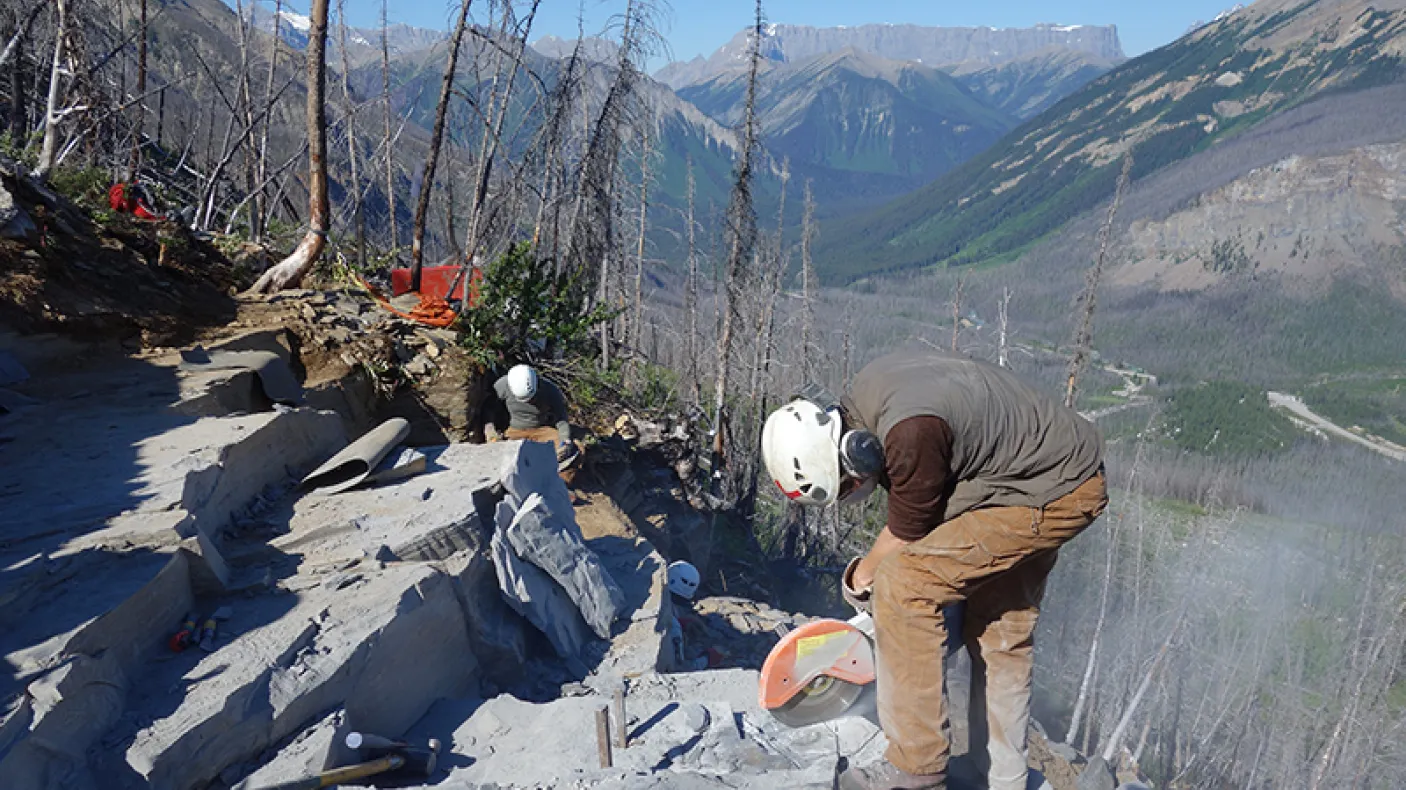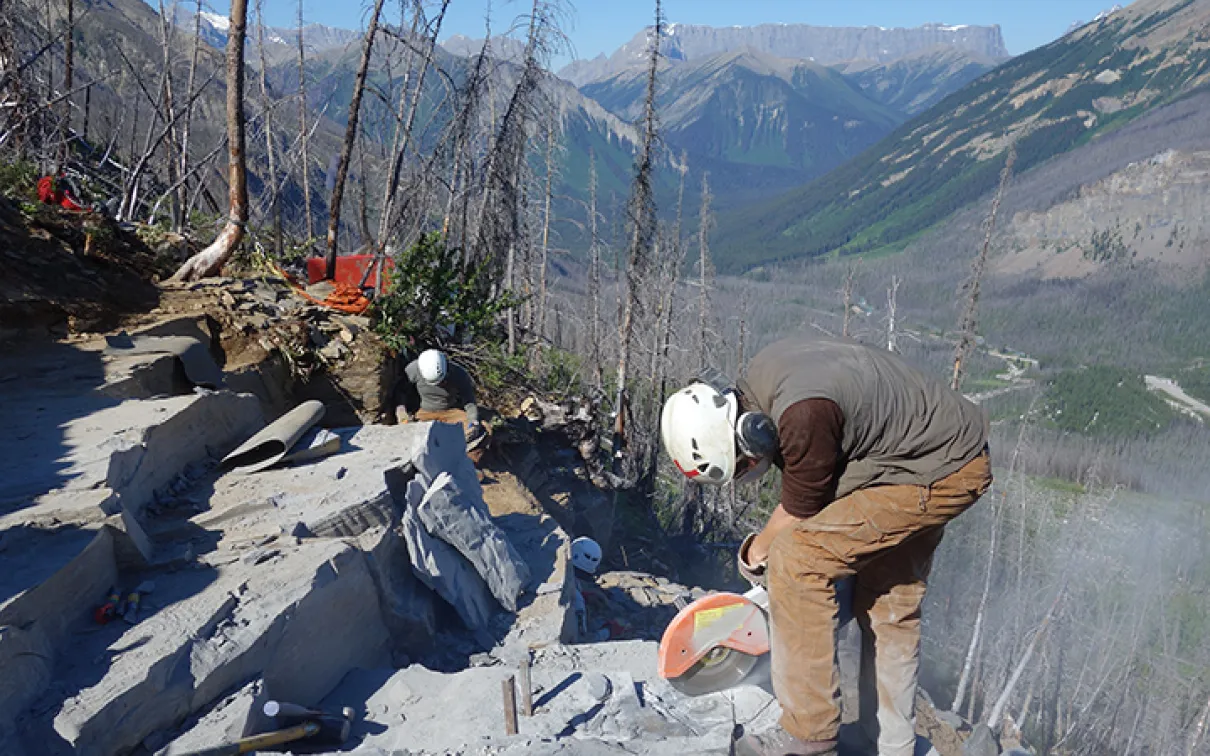Tokummia, a new fossil species from the Burgess Shale traces origin of ants, millipedes and lobsters.
Published
Categories
Author
Blog Post
Guest Blog by Cédric Aria, recent PhD graduate from Dept. of Ecology and Evolutionary, UofT, who was based at the ROM. Currently a post-doctoral researcher at the Nanjing Institute of Geology and Palaeontology.
Science is now commonly seen as an arrow of progress. More and more, through books, through the media, the scientific creature is shown marching forward, devouring discoveries after discoveries keeping it healthy and moving. But science can be a slow beast that sometimes takes a different direction and wanders, even if it may occasionally fall back near its former path.
As a cradle of both the familiar and the bizarre, the half-a-billion-year-old marine fauna of the Burgess Shale has long been illustrating such intellectual wanderings, sometimes at the highest levels of animal classification—take Hallucigenia, Nectocaris, or Haplophrentis. However, the arthropods (this hyperdiverse group of invertebrate animals with articulated limbs), and apart from the classic and ancestral “weird wonders” with unarticulated bodies such as Opabinia or Anomalocaris, have in general been the subject of less dramatic switchbacks, but more of “small adjustments.”
Now, it seems that the iconic “bivalved arthropods,” which are among the very first fossils discovered by Charles Walcott from the Burgess Shale—and sketched in his 1909 field notebook—have a story with more “potential energy” to tell.
The culprit’s name is Tokummia katalepsis, just published with Jean-Bernard Caron, my former Ph.D. supervisor and senior curator of invertebrate palaeontology at the ROM, in the scientific journal Nature (read paper). Tokummia was first found near Marble Canyon in Kootenay National Park, British Columbia in 2012 by a Royal Ontario Museum(ROM)-led team of researchers, students and volunteers. I had just started my Ph.D. at the time so this was a most opportune moment to join on a fieldwork trip to the Rockies. Marble Canyon is shaped by Tokumm Creek, visible from the fossil quarry across the valley and after which we named the genus of the new arthropod.
It took that seminal field season in 2012, another hefty one of quarry work in 2014, and research at the ROM—where the Burgess Shale and Marble Canyon collections are stored and where I had an office—over two more years to finally produce a manuscript ready for submission. You could say that Tokummia had remained my alluring companion through all my degree, which I completed only a few months ago, before moving to Nanjing, China, where I now work as a post-doctoral researcher.
Although the fossil specimen found in 2012 had stood out already, we had not found enough material at that time to go very far, or even to think that it would. But in 2014, Tokummia quickly became a “shining star” around the quarry. As we would split open those large slabs of shale with road-construction-type jackhammers, hand-sized Tokummia specimens would glitter as the sunlight reached the surface of the rock, stealing the fame from Yawunik and Sidneyia. It became clear that this animal had a lot more to offer, and we knew that a lot was at stake with bivalved arthropods—but, in the end, Tokummia surpassed our expectations.
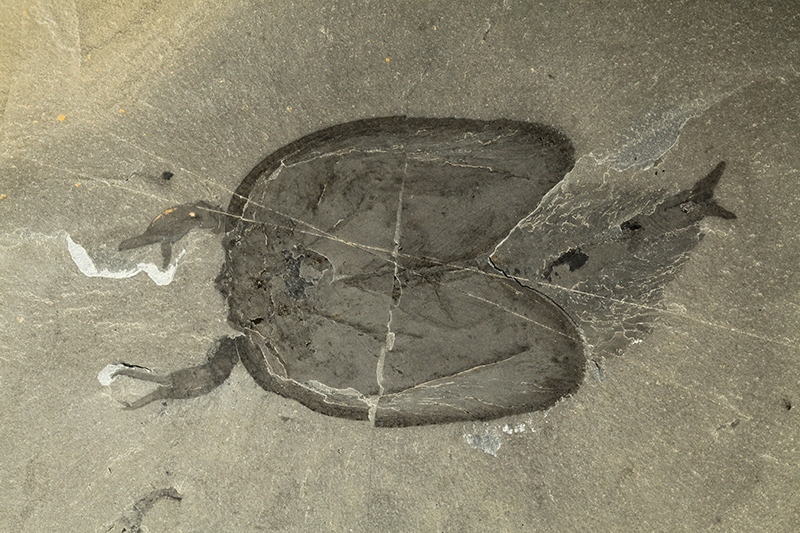
In front of its two valves, the most immediately distinguishing features of Tokummia are its large pincers, an invitation to call the species “katalepsis,” meaning “grasping, seizing” in Greek. These claws are also quite specialized, with one article (the fixed one, called pollex) bearing two terminal teeth, and the other (the movable one, called dactyl) with a sharp edge and curved-in tip. The first image that came to me when I started looking at these appendages was that of an old can opener. In spite of their shape, these pincers were likely not robust enough to deal with the hardest shells or shields, such as those of trilobites. I rather see Tokummia feeding on smaller soft-bodied arthropods or on Oesia worms, which are abundant at Marble Canyon.
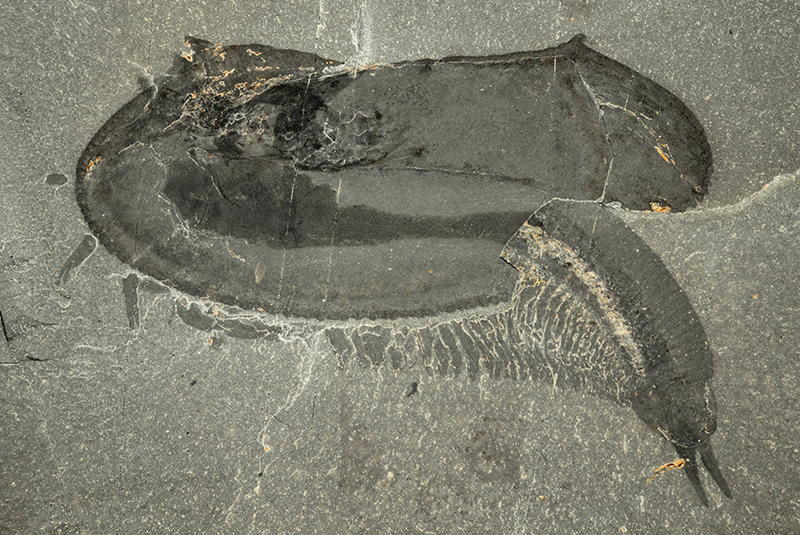
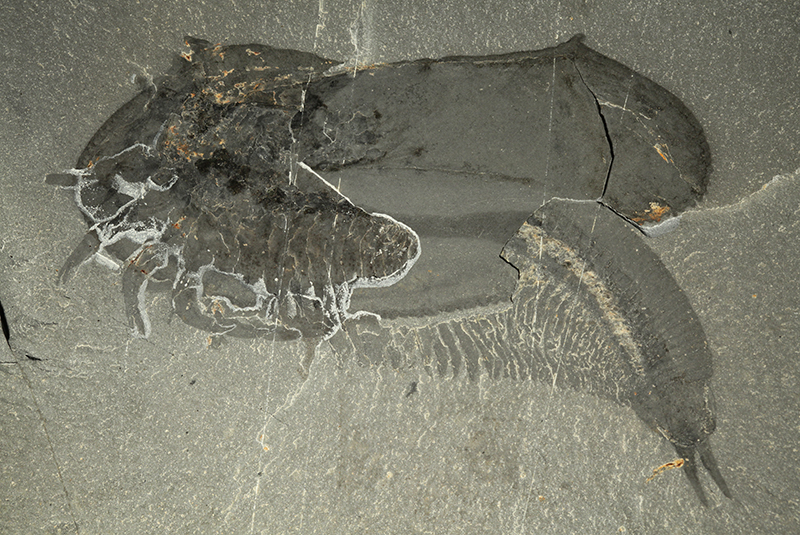
The most critical trait was hidden under the carapace, however, and stayed that way long after we had collected the specimens and started trying to understand the significance of that species. Even after intense days of fossil preparation during which every new appendage revealed was cause for thrills and original theories, we still did not know (at least for sure) that it was there. I am talking about the mandibles, which were eventually found in a molt, along with the seemingly cryptic but quite important projections on the limbs called “endites.”
Why did mandibles matter? They are simply the one clearest diagnostic character giving its name to a gigantic group of arthropods called the “mandibulates,” encompassing centipedes, shrimps, barnacles, pill bugs, and millions of insects. Mandibles are arthropod “jaws,” if you will, and can take various forms, such as serrated plates or protruding dentate blades, as you might know them in certain insects. But we think that they all originate from a single ancestor and were decisive in the unmatched success of mandibulates. As for “endites,” they would be typically found today in crustacean larvae, but Tokummia suggests they are remnants of limb bases divided into several sub-segments—this condition would also be typical of mandibulates, and would have facilitated the diversification of leg morphologies in this group, as well as the appearance of the mandibles themselves.
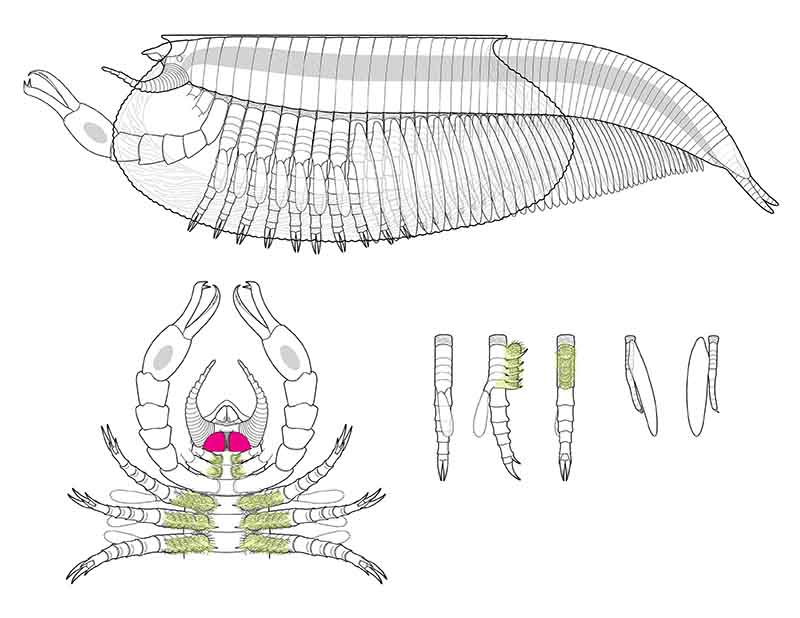
When Walcott first described the large bivalved arthropods from the Burgess Shale, he considered them to be crustaceans—by today’s standards, that made them mandibulates, but that concept was ethereal at that time, and other characters than the mandibles were put forward (carapace type, body shape, supposed limb morphology), although not necessarily with great accuracy or consistency with the requirements of crustacean taxonomists.
During a major wave of redescriptions of the Burgess Shale animals in the 70s, led by Harry Whittington from the University of Cambridge, Derek Briggs had identified such inconsistencies, and the bivalved arthropods were shown to fit both inside and outside of our modern conception of crustaceans. With difficulties to find typical crustacean “heads” and notably mandibles, they could but eventually drift away from such classification.
This migration reached a paroxysm with the publication of a paper in the early 2000s presenting these bivalved species as some of the earliest “true arthropods” (with appendages and bodies both articulated), based on a strict interpretation of their known heads as having one or two pairs of appendages. They would have therefore represented very ancestral (a better word for “primitive”) arthropods, a significant leap (down their tree of life) from being representatives of a modern group such as crustaceans. This view was then largely declined by other authors, to the point of becoming a recurrent assumption in the elaboration of new theories about the evolution of arthropods.
Tokummia throws a pebble (or a carapace) in this pond of ideas (called a paradigm in philosophy of science), and the little waves are bringing back some old leaves to the shore. Not that these mandibles and spinose limbs make a crustacean out of Tokummia, but we think that this animal, along with its bivalved relatives, are among the earliest of mandibulates—and certainly the best known of these early forms. They do tell us about the origin of modern species, and cannot be the earliest of arthropods.
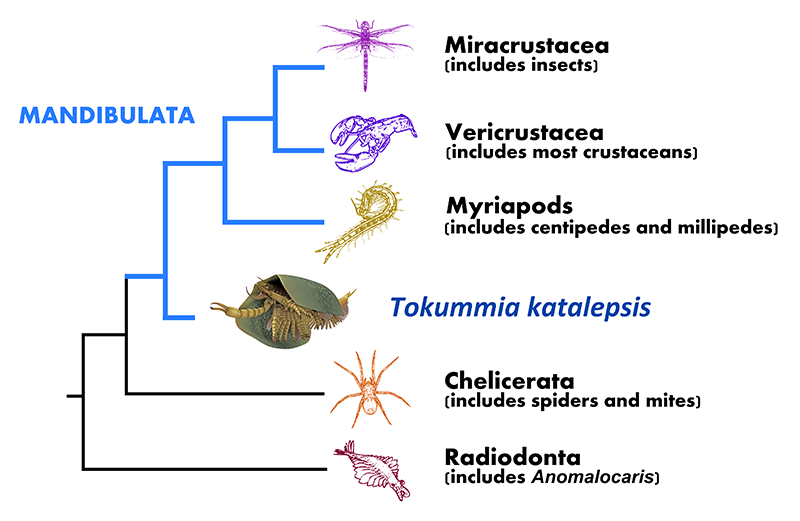
Tokummia: walkcycle
This animation depicts Tokummia walking on the bottom of the seafloor.
Image credit: 3D animation by Lars Fields
3D animation of Tokummia: rotation
This animation shows Tokummia in a 360-degree rotation.
Image credit: 3D animation by Lars Fields
